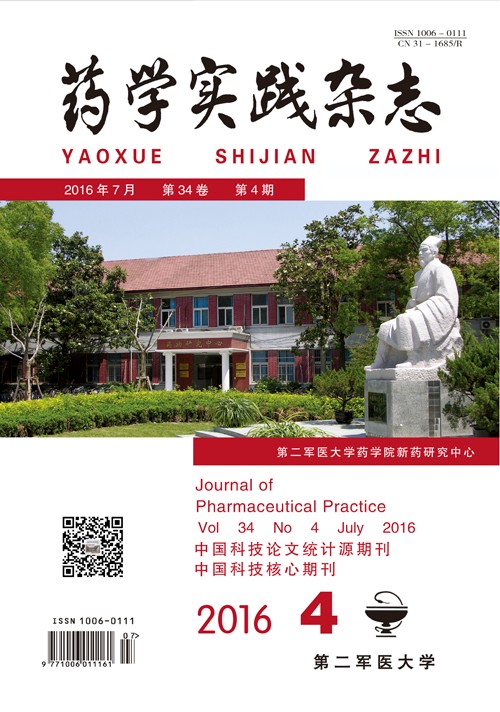ZHANG Zhiqiang, FU Ben, WANG Baogang, ZHANG Chao, LIAO Wanqing, PAN Weihua, GUO Zhongwu. Synthesis and antifungal activities of novel triazole derivatives containing sulfur atoms[J]. Journal of Pharmaceutical Practice and Service, 2016, 34(4): 334-337. doi: 10.3969/j.issn.1006-0111.2016.04.013
| Citation:
|
ZHANG Zhiqiang, FU Ben, WANG Baogang, ZHANG Chao, LIAO Wanqing, PAN Weihua, GUO Zhongwu. Synthesis and antifungal activities of novel triazole derivatives containing sulfur atoms[J]. Journal of Pharmaceutical Practice and Service, 2016, 34(4): 334-337. doi: 10.3969/j.issn.1006-0111.2016.04.013
|
Synthesis and antifungal activities of novel triazole derivatives containing sulfur atoms
- 1.
Department of Organic Chemistry, School of Pharmacy, Second Military Medical University, Shanghai 200433, China
- 2.
Department of Dermatology, Changzheng Hospital Affiliated to Second Military Medical University, Shanghai 200003, China
- Received Date: 2016-01-07
- Rev Recd Date:
2016-03-17
-
Abstract
Objective To design and synthesis novel triazole antifungal derivatives with dithiocarbamates side chain and study the antifungal activities. Methods Nine title compounds were synthesized and characterized by 1H NMR, MS spectra. The in vitro antifungal activities of all the compounds were evaluated against eight human pathogenic fungi. Results The title compounds exhibited strong antifungal activities. Some compounds showed excellent activities against Candida albicans with the MIC80 values less than 0.125 g/ml, 6d was 64 times higher than that of Itraconazole. Conclusion The introduction of the propyl, sulphur and benzyl moiety to the side chain could affect the antifungal activities.
-
References
|
[1]
|
Edmond MB, Wallance SE, McClish DK, et al. Nosocomial bloodstream infections in United States hospitals:a three-year analysis[J]. Clin Infect Dis, 1999, 29(2):234. |
|
[2]
|
Li L, Ding H, Wang B, et al. Synthesis and evaluation of novel azoles as potent antifungal agents[J]. Bioorg Med Chem Lett, 2014, 24(1):192-194. |
|
[3]
|
Marr KA, Carter RA, Crippa F, et al. Epidemiology and outcome of mould infections in hematopoietic stemcell transplant recipients[J]. Clin Infect Dis, 2002, 7:909-917. |
|
[4]
|
Ramirez E, Garcia-Rodriguez J, Borobia AM, et al. Use of antifungal agents in pediatric and adult high-risk areas[J]. Eur J Clin Microbiol Infect Dis, 2012, 3:337-347. |
|
[5]
|
Desai VC, Cavanaugh TM, Kelton CM, et al. Trends in the utilization of, spending on, and prices for outpatient antifungal agents in US Medicaid programs:1991-2009[J]. Clin Ther, 2012, 10:2118-2131. |
|
[6]
|
Jiang Z, Wang Y, Wang W, et al. Discovery of highly potent triazole antifungal derivatives by heterocycle-benzene bioisosteric replacement[J]. Eur J Med Chem, 2013, 64:16-22. |
|
[7]
|
Wang S, Jin G, Wang W, et al. Synthesis and structure-activity relationships of new triazole derivatives containing N-substituted phenoxpropylamino side chains[J]. Eur J Med Chem, 2012, 53(4):292-299. |
|
[8]
|
Richardson K. Antifungal 1,3-bis-triazolyl-2-propanol derivative:4404216[P]. USA, 1983-09-13. |
|
[9]
|
Zou Y, Yu S, Li R, et al. Synthesis, antifungal activities and molecular docking studies of novel 2-(2,4-difluorophenyl)-2-hydroxy-3-(1H-1,2,4-triazol-1-yl)propyl dithiocarbamates[J]. Eur J Med Chem, 2014, 74:366-374. |
|
[10]
|
National Committee for Clinical Laboratory Standards. Reference method for broth dilution antifungal susceptibility testing of yeasts approved standard[S]. Document M27-A2, Wayne, PA, 2002. |
-
-
Proportional views

-







 DownLoad:
DownLoad: